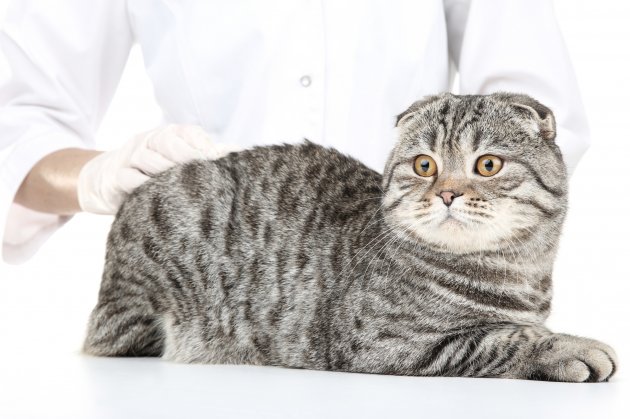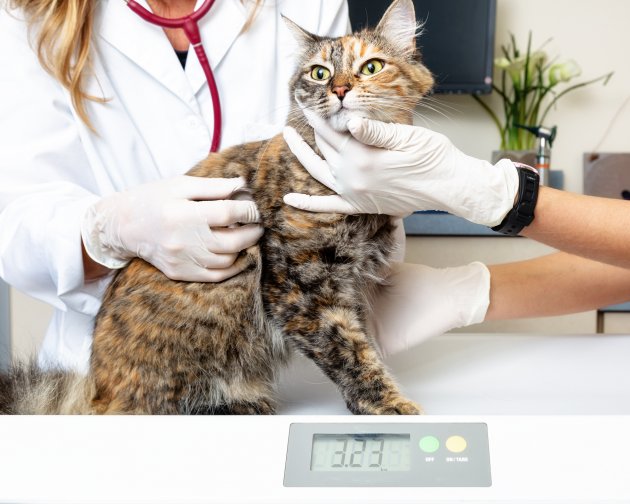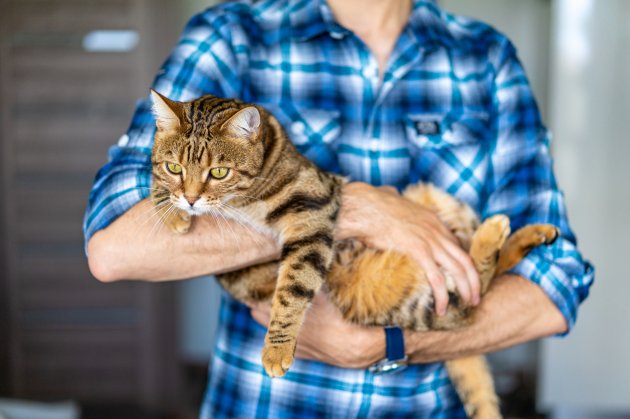Cats have nine lives…but can they dodge these ten common cat health problems?
Responsible cat guardians will be interested to note that many of these conditions are preventable…not all, but some. So with a little knowledge you can keep Kitty purring with good health for longer. And for those conditions that are unavoidable, know that early treatment extends good quality life.

#1: Over grooming
Is your cat an obsessive licker? Indeed, some cats are secret groomers and a giveaway clue to this is a bald belly. This can be a symptom of itchiness due to parasites or an allergic reaction. Or it can also be a sign of stress, because licking is a similar comfort as a child sucking their thumb.
Signs to watch out for include:
- Constant scratching or licking
- Bald patches
- Skin sores
- Tiny scabs on the skin surface
To prevent the problem use a licensed flea product monthly (or as stated on the packaging.) and environmental control in the house. Make the home a safe, calm place to be, and if the symptoms continue see the vet.
#2: Diarrhoea
A foul mess in the litter box is not nice for anyone. But liquid stools aren’t just unpleasant, they are a sign of ill health. There are lots of different causes including:
- Eating something that’s difficult to digest
- Food allergy
- Inflammatory bowel disease
- Parasites
- Colitis
- Bowel cancer
If the cat is otherwise well, a good starting point is to put Kitty on a bland diet of white meat with a small amount of boiled white rice or pasta. Cat probiotics can also help (NOTE: These are cat-specific probiotics so giving the human version doesn’t cut it.)
Red flag signs that a vet visit is essential include:
- Blood
- Weight loss
- Vomiting and diarrhoea
- The cat is unwell
- The diarrhoea persists above 48 hours
#3: Feline Lower Urinary Tract Disease (FLUTD)
Signs to be alert for include:
- Repeated straining to pass urine
- Bloody urine
- Visiting the box but no puddle appears
- Excessive licking of the back end
- Restlessness and distress
If the cat is male blood clots can block the urethra, which is an emergency situation. Male cats that show signs of urinary discomfort must see the vet immediately.
The causes of FLUTD are controversial and include stress, muscle spasm (of the urethra), urinary crystals, bladder stones, and dietary factors. However, the biggest single action an owner can take reduce the risk is to up fluid intake with a canned diet and providing a pet drinking fountain.

#4: Infectious Diseases
Most of the unwelcome members of this group are preventable and include:
- Parasites such as tapeworm, heartworm, hookworm, and roundworm.
- Viruses such as herpes and calcivirus (cat flu), feline panleukopaenia virus (cat distemper), and feline leukaemia virus
These are preventable with regular use of an effective anti-parasite treatment and regular vaccinations.
#5: Hyperthyroidism
Over active thyroid glands are extremely common in mature or older cats. The symptoms include:
- A hearty appetite but the cat loses weight
- Hyperactivity or unusual kitten-like behaviour
- Increased thirst and large puddles in the tray
- A starry unkempt coat
There are a wealth of options for treating hyperthyroidism, ranging from a special diet to surgery, pills to radioactive iodine treatment. The outlook with treatment is excellent, but untreated complications will develop such as heart and kidney failure.
#6: Kidney Disease
A diagnosis of kidney disease is something every cat guardian dreads. But the diagnosis isn’t the bad news that most people assume. With early diagnosis and careful management kidney-cats can live on for years.
Signs of renal disease include:
- Drinking more
- Large puddles in the litter box
- Weight loss
- Reduced appetite
- Vomiting
Treatments include prescription food, ACE inhibitor drugs that help the kidney to function, control of high blood pressure, and the use of supplements to reduce blood phosphate levels.

#7: Arthritis
Yes, cats get arthritis too…they just don’t make a big fuss about it. The clues can be subtle, such as Kitty no longer jumping up on a favourite sunny window ledge or her coat getting knotty (because her back is too stiff to bend round to groom).
Watch out for
- Stiffness on waking
- Not jumping onto favourite places
- A starry unkempt coat
- Changes in behaviour such as being unusually grumpy
Don’t be scared of spotting your cat is arthritic because there are options to ease the discomfort. These include licensed medications such as meloxicam, joint supplements, heath therapy, and physiotherapy.
#8: Dental Disease
How often do you brush your teeth?
Now imagine you never brushed your teeth…not once in the whole of your life.
It is a rare cat guardian that brushes their fur-friend’s fangs which is why dental disease is so common in cats.
Signs include:
- Bad breath and bad-smelling fur (where Kitty licked herself)
- Asking for food but then not eating
- Messy eating
- Lack of grooming
- Heavy drooling
But bad teeth are more than unpleasant, they have a welfare implication. Along with rotten teeth comes tooth ache, and no-one wants their cat to live in constant pain. Sadly, teeth cleaning is preventative and won’t cure a tooth root abscess. Sometimes a dental check-up at the vet is the only option to decide on the best way forward.
#9: Diabetes Mellitus
Some breeds, such as the Burmese, have a genetic predisposition to sugar diabetes, whilst for other cats being overweight is a huge risk factor.
Symptoms of diabetes include:
- Increased thirst
- Large puddles in the litter box
- Weight loss
- A dull, starry coat
- Lack of energy
The signs are quite general, but popping a urine sample into the vet will give a quick answer as to whether diabetes is the cause. Diabetes is treatable with daily insulin injections, and keeping the cat slim and active remove two of the major risk factors.
#10: Pancreatitis
Pancreatitis is diagnosed much more frequently than previously because of a reliable blood test. The condition is caused by inflammation of the pancreas which allows leakage of digestive enzymes. This causes stomach ache, poor appetite, and vomiting.
Treatment varies depending on how sick the cat is. This might mean giving anti-acid medications and a bland diet, through to hospitalization for intravenous fluids and pain relief.
And finally, don’t be scared by these problems. The trick is to face up to health concerns and get help. Early diagnosis and treatment is key to getting Kitty back on her paws pronto.